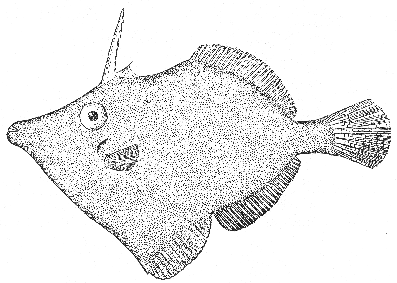Filefish Monacanthus ciliatus (Mitchill) 1818
[Jordan and Evermann, 1896-1900, p. 1714.[96]]

Figure 277.—Filefish (Monacanthus ciliatus), Bahamas specimen, 85 mm. long. Drawing by H. B. Bigelow.
Description—
This filefish resembles the species hispidus (p. 522) very closely. But its first dorsal ray is never prolonged, the ventral dewlap extends somewhat farther behind the tip of the ventral spine, and the caudal peduncle in the adult is armed with 2 or 3 pairs of strong forward-curving hooks on either side.
Color—
Described as varying from olive gray, or grass green to yellowish brown, with darker blotches or crossbands. The dorsal and anal fins are pinkish and they usually have three dark spots at the base. The ventral dewlap is edged with scarlet, and the caudal fin is greenish, mottled dark and pale.
[page 524]Size—
Four to eight inches long.
General range—
Warmer parts of the Atlantic; from Brazil to Cape Cod on the American coast. A straggler has even been reported from Argentia, on the southern coast of Newfoundland, far to the north of its normal range.[97]
Occurrence in the Gulf of Maine—
The only recent report of this filefish from within the Gulf of Maine is of a 7-inch specimen taken in a trap at Provincetown, November 9, 1929.[98] We judge that earlier reports of it from Massachusetts Bay referred to in Storer's description and illustration[99] were actually based on a specimen of hispidus.
[96] The illustration labeled "ciliatus" by Jordan and Evermann (Bull. 47, U. S. Nat. Mus., Pt. 4, 1900, pl. 259, fig. 634) is actually of hispidus, as is their figure 635.
[97] Newfoundland Fish. Res. Comm. Rept., vol. 1, No. 1, 1933, p. 126.
[98] Firth, Bull. Boston Soc. Nat. Hist., No. 61, 1931, p. 13.
[99] The illustration of his Monacanthus massachusettensis shows the profile typical of hispidus, and neither his description nor his illustration suggests that there were any thorns on the caudal peduncle such as characterize ciliatus. (See Storer Mem. Amer. Acad. Arts, Sci., N. Ser., vol. 8, 1863, p. 425, pl. 34, fig. 4; also Fishes of Massachusetts, 1867, p. 231, pl. 34, fig. 4.)